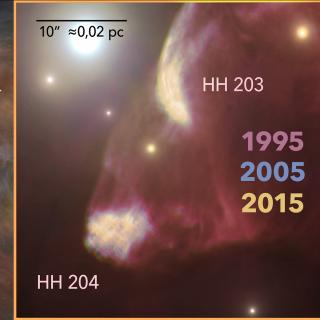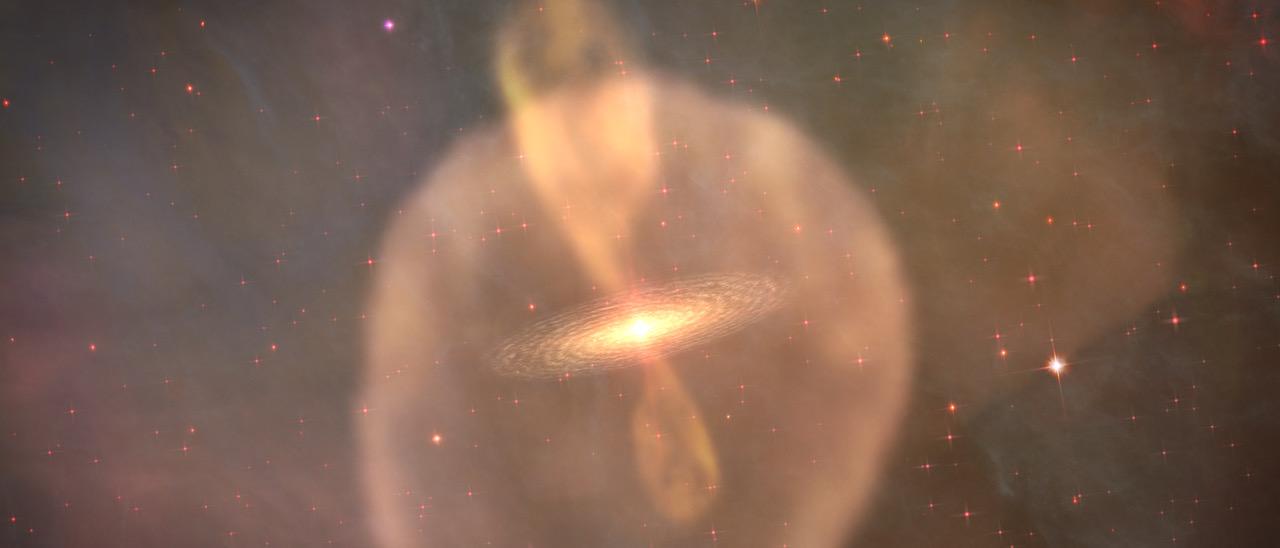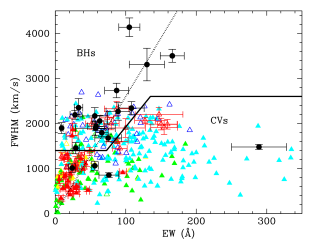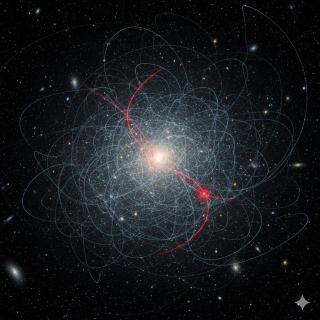International research led by scientists at the Instituto de Astrofísica de Canarias (IAC) has shown the existence of solid sulphur compounds in HH514, a jet of gas coming from the centre of the Orion Nebula. The concentration of this chemical element could be related to the process of exoplanet formation. The researchers have used three of the most important optical telescopes in the world: the Very Large Telescope (VLT), the Gran Telescopio Canarias (GTC or Grantecan) and the Hubble Space Telescope (HST). The results are published in the scientific journal Monthly Notices of the Royal Astronomical Society.
In the Orion Nebula there are large numbers of protostars and protoplanetary discs. They are bathed in the intense field of ultraviolet radiation produced by the stars in the Trapezium of Orion, which ionize the gas and which can photo-evaporate these structures, and disintegrate them. For this reason planet formation is considered rather improbable in this hostile environment. However the chemical composition of the many jets of gas which originate in the protoplanetary discs, andwhich are emitted into their environment can give us clues about this phenomenon.
Solid dust particles which are dragged and shocked by these jets can be destroyed, liberating their atoms into the gas phase, and enhancing their concentration. When planets form in a protoplanetary disc the accretion of material is not uniform; the large grains of dust, typically sulphides, can be trapped and grow, as recent theoretical studies have shown.
Now, research led by the IAC has found, in a jet of gas in HH514, in the very centre of the Orion Nebula, a concentration of sulphur twice as high as the solar value, which could be explained by the destruction of reservoirs of dust grains rich in sulphides. The high abundance of these compounds seems to show that there has been, or that there still is planet formation in the protoplanetary disc from where the jet is coming.
“Sulphur is an important element for protein synthesis in living beings” explains José Eduardo Méndez Delgado, an IAC researcher who is the first author of the paper. "In the nebulae where stars form sulphur is mainly found in the gas phase, but on Earth we find it in rocks containing sulphides”. He emphasizes that the processes causing the change of sulphur from gas to dust, or viceversa, in the Universe in general are not well known. “Although various ideas have been proposed, we still lack the evidence to know just what is happening in the Orion Nebula. Our work on HH514 will give us a better understanding of this phenomenon, and will attract other researchers to analyse this subject.”
This rersearch has been carried out using observations from three of the most important optical telescopes, the VLT, the HST, and the GTC; the latter is situated in the Roque de los Muchachos Observatory (Garafía, La Palma). “Interpreting the results we obtained has been challenging. We have rejected many of the options which could explain the strange over-abundance of sulphur in HH514, although it is possible that there are still some details we are missing” says César Esteban, an IAC researcher and a co-author of the article.
“It’s clear that the Orion Nebula still has many secrets to interpret. The connection between the jets of gas and possible planet formation in the Orion Nebula shows the interconnection between different fields of knowledge, and that only by collaborating will we gain improved understanding of the problema” concludes Jorge García Rojas, an IAC researcher (Severo Ochoa Advanced Fellow) and a co-author of the article.
Article: Méndez-Delgado, J. E.; Esteban, C.; García-Rojas, J. & Henney, W. J. “Photoionized Herbig-Haro objects in the Orion Nebula through deep high-spectral resolution spectroscopy III: HH514”. Monthly Notices of the Royal Astronomical Society. DOI: https://doi.org/10.1093/mnras/stac1300
Arxiv: arXiv:2205.03266
Contact at the IAC:
José Eduardo Méndez Delgado: jemd [at] iac.es (jemd[at]iac[dot]es)
César Esteban: cel [at] iac.es (cel[at]iac[dot]es)
Jorge García Rojas: jogarcia [at] iac.es (jogarcia[at]iac[dot]es)






